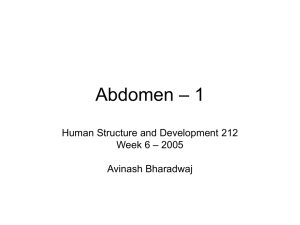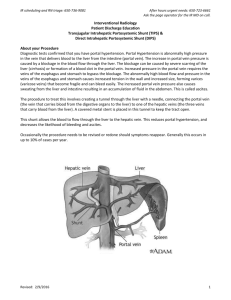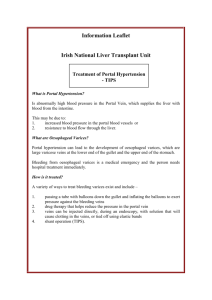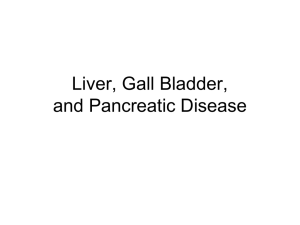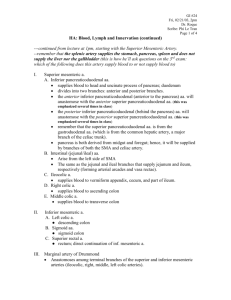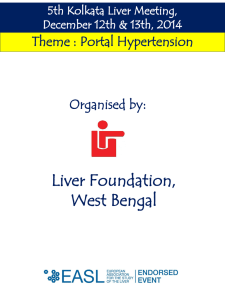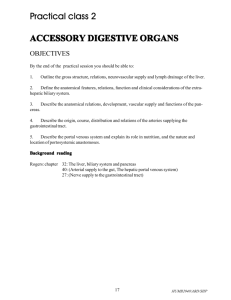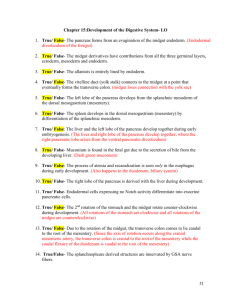Gastro61&62-Exam3Review
advertisement
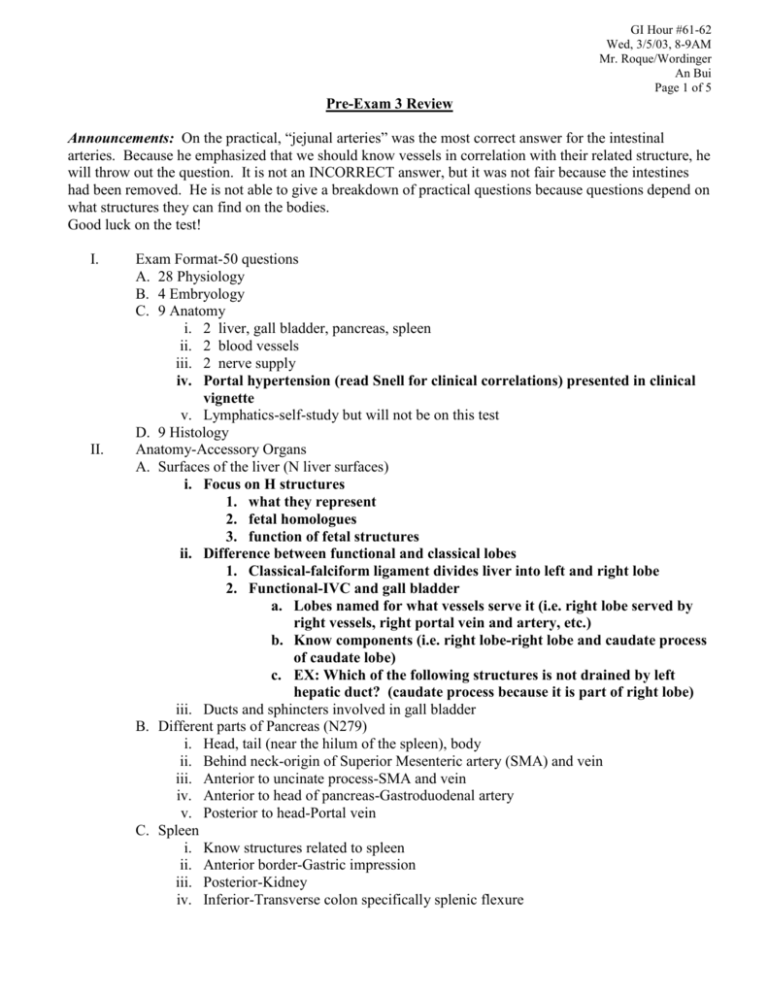
GI Hour #61-62 Wed, 3/5/03, 8-9AM Mr. Roque/Wordinger An Bui Page 1 of 5 Pre-Exam 3 Review Announcements: On the practical, “jejunal arteries” was the most correct answer for the intestinal arteries. Because he emphasized that we should know vessels in correlation with their related structure, he will throw out the question. It is not an INCORRECT answer, but it was not fair because the intestines had been removed. He is not able to give a breakdown of practical questions because questions depend on what structures they can find on the bodies. Good luck on the test! I. II. Exam Format-50 questions A. 28 Physiology B. 4 Embryology C. 9 Anatomy i. 2 liver, gall bladder, pancreas, spleen ii. 2 blood vessels iii. 2 nerve supply iv. Portal hypertension (read Snell for clinical correlations) presented in clinical vignette v. Lymphatics-self-study but will not be on this test D. 9 Histology Anatomy-Accessory Organs A. Surfaces of the liver (N liver surfaces) i. Focus on H structures 1. what they represent 2. fetal homologues 3. function of fetal structures ii. Difference between functional and classical lobes 1. Classical-falciform ligament divides liver into left and right lobe 2. Functional-IVC and gall bladder a. Lobes named for what vessels serve it (i.e. right lobe served by right vessels, right portal vein and artery, etc.) b. Know components (i.e. right lobe-right lobe and caudate process of caudate lobe) c. EX: Which of the following structures is not drained by left hepatic duct? (caudate process because it is part of right lobe) iii. Ducts and sphincters involved in gall bladder B. Different parts of Pancreas (N279) i. Head, tail (near the hilum of the spleen), body ii. Behind neck-origin of Superior Mesenteric artery (SMA) and vein iii. Anterior to uncinate process-SMA and vein iv. Anterior to head of pancreas-Gastroduodenal artery v. Posterior to head-Portal vein C. Spleen i. Know structures related to spleen ii. Anterior border-Gastric impression iii. Posterior-Kidney iv. Inferior-Transverse colon specifically splenic flexure GI Hour #61-62 Wed, 3/5/03, 8-9AM Mr. Roque/Wordinger An Bui Page 2 of 5 III. v. Pancreas impression vi. Spleen derived from dorsal mesentery (NOT FROM THE GUT) Anatomy-Blood Supply A. Arteries of the abdomen i. Abdominal Aorta-3 sets of blood vessels that supply abdomen arise from Aorta 1. 2 paired (there is a right and left branch) a. Supply urogenital tract (supply kidneys, genitals, etc.)-come off of side of aorta b. Posterior blood supply to abdominal wall branch from posterior intercostals 2. 1 unpaired set arises from medial anterior part a. Celiac-supplies foregut (structures below diaphragm) b. SMA supplies midgut (i.e. Appendix) c. Inferior Mesenteric artery supplies hindgut B. Know embryological structures and adult structures derived from them! i. Foregut, midgut, hindgut, and blood supply ii. Junctions between structures in the adult 1. Junction of foregut and midgut- vicinity of major duodenal papilla - other structures found here: hepatopancreatic ampulla, entry of common bile duct 2. Junction of midgut and hindgut-distal 1/3 of transverse colon, proximal 2/3 of anal canal iii. All accessory structures derived from foregut except spleen (supplied by Celiac artery but NOT derived from foregut) iv. Pancreas-derived from foregut and midgut 1. dual blood supply-Celiac and SMA v. Do not need to know embryological rotations around the axes for test vi. Know different structures derived from mesenteries 1. Ventral mesentery a. Lesser omentum (hepatoduodenal and hepatogastric ligaments) b. Falciform ligament 2. Dorsal mesentery a. Mesentery of small intestine b. Greater Omentum c. Sigmoid mesocolon vii. Ex. Questions: 1. What is the blood supply to the hepatic flexure? –SMA (supplies midgut), major branches=right colic and middle colic 2. Splenic artery supplies which of the following structures? --All foregut structures-Ascending colon is NOT correct (derived from midgut) C. Portal Vein-very important i. Tributaries 1. Formed by union of superior mesenteric and splenic vv., posterior to the head of the pancreas. 2. inferior mesenteric v. drains into splenic vein or directly into the portal vein 3. paraumbilical vv.-drain into the portal vein GI Hour #61-62 Wed, 3/5/03, 8-9AM Mr. Roque/Wordinger An Bui Page 3 of 5 ii. Anastomoses between branches of portal and systemic (caval) circulations: 1. Left gastric v.-azygos vv. 2. Superior rectal v.-middle rectal v. and inferior rectal v. 3. Paraumbilical vv.-ant. abdominal vv. 4. Retroperitoneal vv.-lumbar vv. 5. Veins in bare area of the liver-veins of diaphragm and internal thoracic v. iii. Portal Hypertension 1. Be careful and make sure you know what the main manifestations are for portal hypertension vs. the symptoms of the main problem that are not caused by portal hypertension 2. Primary clinical manifestations a. Enlarged veins due to back up of blood in liver b. Increase pressure in portal vein, blood cannot go to liver, has to go backwards c. varicose veins (enlarged veins) i. Occur at portal-caval anastomoses (where you have both portal vein and vena cava tributaries) ii. Esophagus- food erodes mucosal lining-vomiting blood (from esophageal v.) iii. Rectum-hemorrhoids and bleeding from the anus (from enlarged superior rectal v.) iv. Caput medusae around umbilicus d. Splenic vein backup leads to splenomegaly-no anastomoses 3. Conditions causing secondary portal hypertension: a. Problems affecting liver-cirrhosis of liver b. Problems occurring above liver-Right heart failure leads to backup in Inferior vena cava c. Tumor of head of pancreas putting pressure on portal vein d. cirrhosis of liver, jaundice and gynecomastia-caused by portal hypertension? No! e. These conditions cause blockage of the portal vein, but are not manifestations due to portal hypertension iv. With blockage of portal vein, liver is still supplied by hepatic artery v. External iliac begins femoral v -drains leg, lower extremity vi. Internal iliac-drains pelvis and reproductive system 1. middle rectal is a tributary D. Nerve supply i. Know what structures innervate the GI tract 1. Foregut a. Thoracic splanchnic n. b. Vagus n. 2. Midgut a. Thoracic splanchnic n. b. Vagus n. 3. Hindgut a. Lumbar splanchnic (descending colonsigmoid colon) b. Sacral splanchnic n. (rectum) GI Hour #61-62 Wed, 3/5/03, 8-9AM Mr. Roque/Wordinger An Bui Page 4 of 5 c. Pelvic splanchnic n. ii. Sympathetics 1. Derived from thoracolumbar 2. Thoracic, lumbar, and sacral splanchnic nn. 3. Preganglionic fibers synapse on the aorta 4. Postganglionic fibers continue through mesentery to viscera iii. Parasympathetics 1. Vagus n. 2. Pelvic splanchnic n. 3. Preganglionic fibers DO NOT synapse, they pass through mesentery to viscera 4. Distributed on viscera by Auerbach’s (myenteric) and Meissner’s (submucosal) plexus IV. Histology-Intestines A. Small intestine i. Increase surface area (SA) for absorption 1. Plicae circulares-folds in intestinal wall 2. Villi-important for SA a. lamina propria has lacteal for fat absorption b. covered by simple squamous absorptive epithelium with goblet cells c. become shorter as you approach colon-no villi in colon 3. Microvilli-finger-like invaginations off each individual columnar cell, greatest increase in SA ii. Glands 1. Invaginations of surface epithelium at base of villi 2. Exocrine glands punching into epithelium in area of muscularis mucosa 3. Structural features similar to gastric glands 4. Paneth Cells-make lysozymes 5. Most important: base has undifferentiated stem cells (mitotic) a. migrate to tips of villi to replace villi cells lost iii. Ganglion-myenteric and submucosal plexi iv. No glands in submucosa in small intestine except: 1. Glands of Brunner in duodenum-secrete alkaline mucus v. Some lymphatics may be present in mucosa vi. Ileum-Peyer’s patches (diffuse lymphoid tissues that go on to form lymph nodules) vii. Enteroendocrine cells in intestinal glands B. Large intestine i. Similar to small intestine ii. no villi iii. Increase population of goblet cells-facilitate solid material flow C. Appendix has large amount of lymphoid tissue D. Anal canal i. Keratinized stratified squamous epithelium as it merges with skin GI Hour #61-62 Wed, 3/5/03, 8-9AM Mr. Roque/Wordinger An Bui Page 5 of 5 ii. Few glands-sebaceous and circumanal glands iii. Paneth cells in colon? –disagreement in sources, some say there are, but most say that there are NONE present V. Histology-Accessory organs A. Liver i. Classic liver lobule (structural orientation in liver) 1. central vein-center of hexagonal shape 2. portal triads on periphery a. artery, vein, bile duct b. Connected by vessels all around liver ii. Portal-Emphasize exocrine secretion (triangle) iii. Rappaport-emphasize metabolic (diamond shape) 1. Zone 1-closest to triad 2. Zone 2 3. Zone 3-least amount of product entering liver **Remember the 3 lobules described above are IMAGINARY ways to orient things in the liver, not structurally how things are seen (except for classic lobule) iv. Sinusoids 1. hepatocytes (functional cell of liver) a. review list of hepatocyte function-endocrine/exocrine function, drug metabolism, glycogen metabolism, glucose metabolism, synthesis of plasma proteins b. exocrine-bile canaliculi between hepatocyte; move in opposite direction of blood flow c. 3 surfaces of contact: i. Space of Disse (endocrine) ii. Bile canuliculi iii. Neighboring hepatocyte iv. Facilitates ability to diverge products of synthesis to particular surfaces of hepatocyte 2. lined by endothelial-like cell and Kupffer cell (phagocytic abilities to get rid of RBCs) ; 3. Ito cells hard to show but may line sinusoid 4. Space of Disse-anything secreted into blood (endocrine products) must pass into space and pass by these cells B. Gall bladder i. Folds because absorptive organ to concentrate bile ii. Tall columnar absorptive cells iii. Lots of microvilli iv. Lacks submucosa C. Exocrine pancreas i. Similar to parotid gland, major difference are centroacinar cells in pancreas ii. Hormonal control present in pancreas, not parotid

